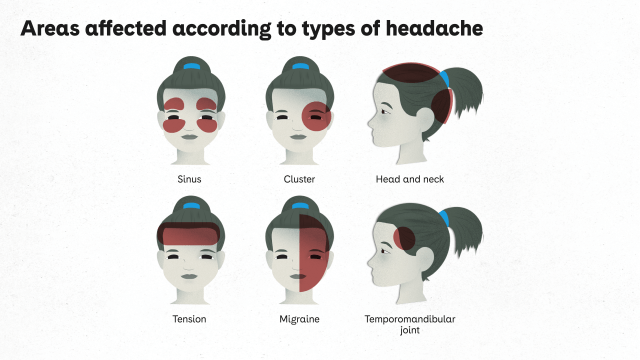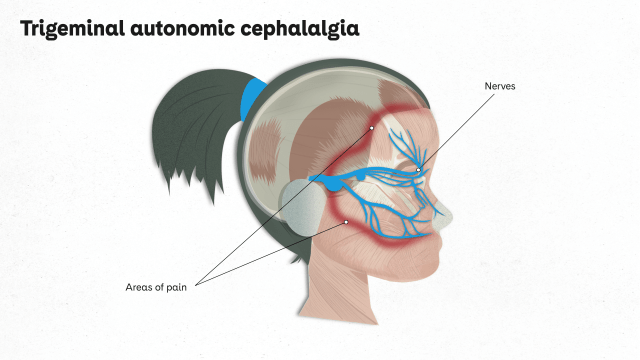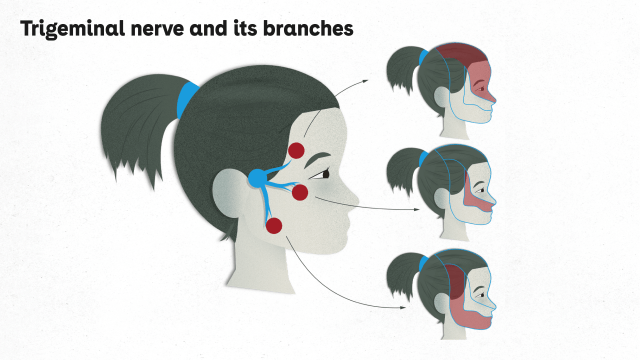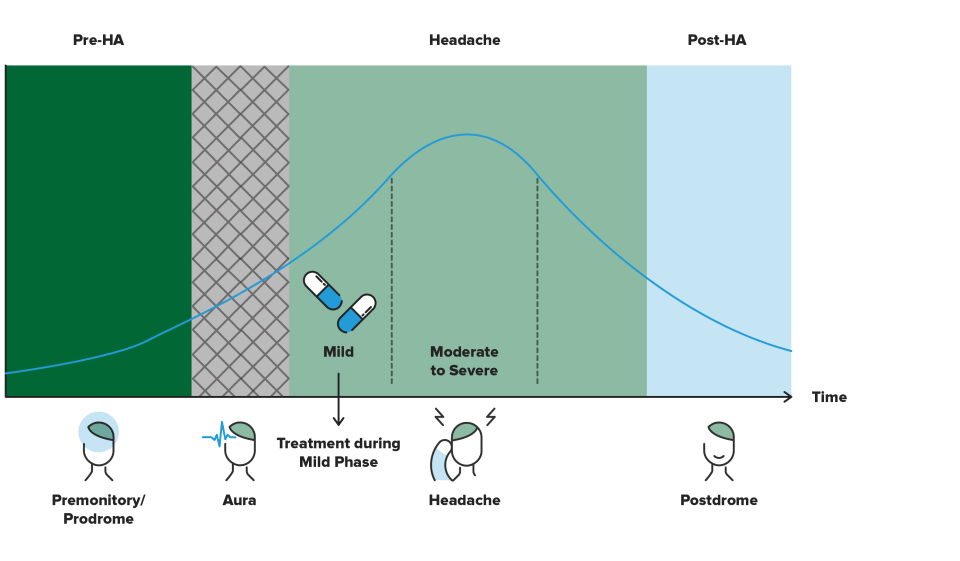Types of Headache

Primary Cephalalgias
Primary Cephalalgias are diagnosed based on the criteria set out in the classification by the International Headache Society. The most common is the tension headache, but migraine is the reason for the greatest number of visits to the neurology clinic, according to data published by the World Health Organisation. It is possible that different types of cephalalgia co-exist in some patients that do not fulfil the diagnostic criteria, or that are hiding a secondary headache. For this reason, it is recommended to consult a doctor so that the correct diagnosis may be made and the appropriate treatment indicated, as this is not usually the same for every patient.

Tension headache. It is the most common. It is caused by muscular tension, generally of the forehead and nape of the neck, and usually coincides with periods of stress. This type of headache presents as a persistent tension or pressure, like a helmet, in both sides of the head and predominantly in the forehead and nape of the neck. In many cases, palpation of the muscles affected can induce pain. The intensity of the pain in tension headaches is usually milder and less disabling when compared to cephalalgia caused by migraine or to secondary headaches. The pain usually starts during the day, and is more intense in the afternoon, but it may become chronic, and be present all day for several days.

Migraine or severe Cephalalgia. It is characterised by repeated or recurrent episodes of headache. The intensity can vary in the different episodes, but can be intense, which is when the patient requests medical care. The pain generally begins on one or other side of the head (hemicranial) and spreads to the whole head. It is usually pulsatile, like the beat of the heart, and may be accompanied by nausea and vomiting, as well as a discomfort that gets worse with light (photophobia), noise (phonophobia), and smells (osmophobia). The pain gets worse with physical activity, improves with rest, and can be triggered by periods of stress, changes in sleep pattern (sleep less, or even more than usual), menstruation, climate changes, fasting, or hunger, or some foods.
Migraine can be hereditary, and it is common to find a family history of migraine. It can present as aura migraine (20%) —in which the headache is preceded by visual, sensory, speech or motor symptoms— or as migraine without aura (80%). A patient with an aura migraine can have headache episodes with no aura.
A chronic form is also distinguished, that is to say, patients that suffer from headache more than 15 days a month (could be a migraine or tension), of which at least 8 of them fulfil migraine criteria. Around 2.5% of patients a year go from the episodic to the chronic form. There are some predisposing factors to developing this chronic form of cephalalgia and they are grouped into:
- Non-modifiable factors, like being a woman, a low economic status, or a history of head traumas.
- Modifiable factors, such as an increased frequency of stress, obesity, abuse of analgesic medication, anxiety, depression, caffeine abuse, the presence of other painful symptoms, such as fibromyalgia.

Cough headaches. It is caused by coughing or due to a Valsalva manoeuvre (increase in intra-thoracic, or secondarily intracranial, pressure when sneezing, defecating, lifting weight, etc.). It lasts between 1 second and 30 minutes, a subsequent discomfort persisting for a few hours. Although the majority are primary headaches, it is important to perform an imaging test such as a cranial computed tomography (CT) or brain resonance scan in order to rule out intracranial lesions that increase the pressure.

Headache due to physical effort. It is caused by performing very intense physical exercise. They are usually pulsatile types, and last between 5 minutes and 48 hours. Occurs more frequently in places where it is very hot or at high altitudes. Improves on stopping the activity. Although the majority are primary headaches, it is important to perform an imaging test to rule out secondary causes; the most frequent being brain haemorrhage or subarachnoid haemorrhage.

Headache associated with sexual activity. It is triggered by sexual activity. It may be pre-orgasmic or orgasmic, with the latter being more common. The pain occurs in the sides of the head, reaching its peak when the orgasm comes and last from minutes to hours. Like that in headache due to physical effort, an imaging test should be performed to rule out intracranial or cerebrovascular lesions.

Hypnic headache. It only appears while sleeping, making the patient wake up. It usually affects people over 50 years-old, and tends to be persistent, between 30-180 minutes. It is unspecific, although it shares some characteristics with migraine, such as a feeling of nausea. It is important to rule out a secondary cause when it is of recent onset.

Trigeminal autonomic cephalalgia. Different situations with common clinical characteristics are grouped together: one-sided pain located in the area innervated by the trigeminal nerve and autonomous cranial symptoms (watery eyes, red eye, congestion, or nasal packing, flow of liquid from the nose or rhinorrhoea, facial sweating). They are short-duration and very intense headaches, and with several episodes a day.
The pain and the autonomous symptoms are due to the activation of the trigeminal nerve and the parasympathetic nerve system as a result of the pathological activation of the facial-trigeminal reflex in the brainstem. The hypothalamus is the brain region that acts as a generator that activates this reflex.
Three situations are distinguished, in which the duration and frequency of the attacks help to identify them and thus be able to give specific treatment:
- Cluster headache. It is the most common group. It affects less than 1 in 1,000 adults, being three times more common in males than in females, and usually begins around 30 years of age.It presents as very intense daily or almost daily episodes (between 1 and 8 times, and each episode lasting from 15 to 180 minutes), and also appear at night. The patient is restless, unlike with migraine that prefers to be stretched out and still. The duration of the pain outbreak periods varies between a few weeks and several months, with headache-free intervals, being repeated annually or every few years and, occasionally, it becomes chronic with consecutive outbreaks for more than 1 year. The triggers to avoid are stress, tobacco, alcohol, and naps during periods of pain attacks.
- Hemicranial headache. It affects 1 in 50,000 adults and is three times more common in females than in males, usually in adults. It presents in a form of very tense and short episodes with a duration of between 2 and 30 minutes (generally less than 15 minutes) more than 5 times a day. The location is always on one side and responds to the anti-inflammatory drug, indomethacin.There are two variants: paroxysmal (20% of patients) with long periods free of attacks, and chronic (80%).
- Short-lasting Unilateral Neuralgiform headache attacks with Conjunctival injection and Tearing (SUNCT). It is a very rare situation and its prevalence is unknown. It is slightly more common in males and usually appears around 50 years-old. It presents in a form of very short episodes of moderate-severe intensity, between 5 seconds and, rarely, minutes, repeatedly until up to 200 times a day. They can appear spontaneously, or be triggered by touching the face or the scalp, brushing the teeth, sneezing, shaving, etc.


Trigeminal neuralgia. It is defined as episodes of facial pain on one side of the face, and affects one or more of the three branches of the trigeminal nerve without radiating to other areas. It is characterised by an acute, stabbing or electric pain, with an unexpected beginning and end. It last seconds, and is usually triggered by external stimuli in the “trigger areas” when, for example, shaving, washing the face, blowing the nose, speaking, chewing.
The cause is unknown in the majority of cases, and it mostly affects women over 40 years of age. From 5 to 10% are caused by diseases such as tumours, base of the skull anomalies, cerebral infarction, arterio-venous malformations, multiple sclerosis, etc. A brain magnetic resonance with 3-dimensional reconstruction has to be performed for its diagnosis.

Difference between headache and migraine
Who should have migraine?
It can appear at any age, also in infancy, although it is usually in the second decade of life. In under-age, it is more common in boys, while in the adult age it affects three times more women (15-20% of the general population) than men (5%). Migraine is hereditary. There is a family history in 80% of patients.
Phases of migraine. Migraine is divided into four phases, some of which may or may not be present during the attack.

Prodromes. They are produced up to 24 hours before a migraine develops. These include food cravings, changes in mood for no apparent reason (depression or euphoria), uncontrollable yawning, fluid retention, or increased micturition.

Aura. The most common is visual (blind spots, loss of visual field, sparkles, distortion). The second most common is the sensory aura (it is usually present with the previous, pins and needles usually appear in the fingertips, which will ascend up the arm within minutes until reaching the face). There can also be a speech disorder or loss of strength on one side of the body. It lasts for less than an hour, usually between 15-30 minutes.

Headache. It is on one side; it starts gradually and increases in intensity until it can become disabling with nausea and vomiting. It becomes worse with movement, light, noise, and smells. It is possible to have a migraine with aura and with no headache (migraine equivalent), but it is rare and a stroke or a partial epileptic seizure need to be ruled out first.

Postdrome. There will be fatigue in 80% of patients after pain control, as well as confusion and concentration problems. It can last for up to a day.
Secondary headaches

Due to trauma. Blows to the skull or vertebrae, like those produced by traffic accidents, can cause headaches that may be temporary or chronic (if they last more than three months after the trauma). Not only blows can cause headaches due to trauma, but there are other causes, such as explosions, that can cause the entry of fragments of foreign bodies into the head. In general, these headaches appear along with other symptoms caused by the trauma itself, such as concentration or memory problems, dizziness, and fatigue. In the initial phase of a significant trauma, a subdural or epidural haemorrhage has to be ruled out as it may lead to the death of the patient if not surgically intervened in time.

Due to cerebrovascular disease. This type of headache is a result of the blocking of a cerebral artery (ischaemic stroke), or the rupture of a cerebral artery (cerebral haemorrhage), or an aneurysm (subarachnoid haemorrhage) or a cerebral arterio-venous malformation, or a cerebral venous sinus thrombosis. The headache, which is usually intense, is accompanied by other neurological symptoms.

Due to substance consumption or abstinence. The abusive consumption or inhalations of substances such as alcohol, cocaine, carbon monoxide, or nitric oxide, can also cause and aggravate headaches. Furthermore, the withdrawal of substances that are usually consumed, as can occur with alcohol and drugs, is another of the causes of cephalalgia.

Due to anxiety or depression. When the previously described headache criteria are not met, other secondary headaches have been ruled out, and there is no psychiatric illness, occasionally, it can be attributed to anxiety or depression, if there is an identifiable temporal relationship between both phenomena.

Due to idiopathic intracranial pressure or due to a brain tumour. The headache is usually accompanied by sudden, projectile vomiting, and the pain gets worse in decubitus (when the patient is lying down).

Due to hypotension of the cerebrospinal fluid. The headache typically appears when the person stands up, and starts from the nape of the neck, and then spreads to the whole of the head, sometimes with buzzing in the ears, and disappears in this case with decubitus (a few minutes after lying down). It is due to the loss of cerebrospinal fluid after a lumbar puncture or epidural anaesthesia, or skull injury.
Substantiated information by:


Published: 16 May 2018
Updated: 20 March 2025
Subscribe
Receive the latest updates related to this content.
(*) Mandatory fields
Thank you for subscribing!
If this is the first time you subscribe you will receive a confirmation email, check your inbox


